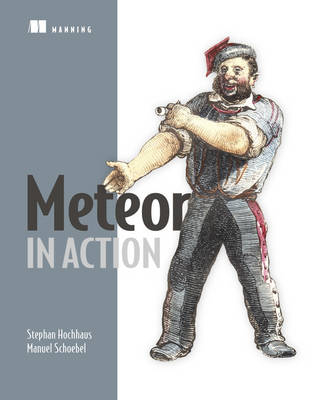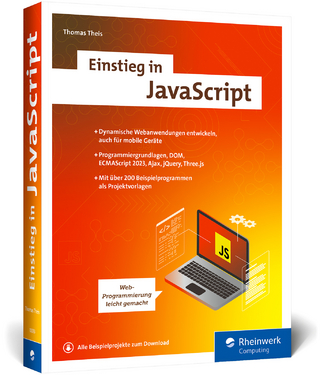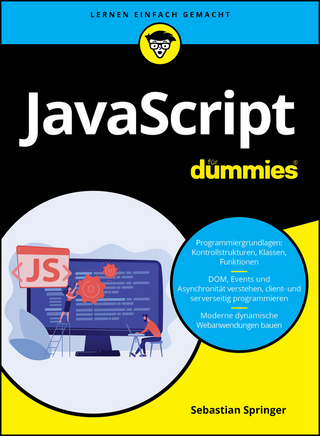
Meteor in Action
Manning Publications (Verlag)
978-1-61729-247-7 (ISBN)
- Titel ist leider vergriffen;
keine Neuauflage - Artikel merken
- Building your first real-time application
- Using MongoDB and other reactive data sources
- Creating applications with Iron Router
- Deploying and scaling your applications
An enjoyable and approachable book.From the Foreword by Matt DeBergalis, Founder Meteor Development Group
Meteor is a unique full-stack framework designed to address some of the most persistent concerns faced when building web applications. It provides the same JavaScript APIs on both the client and server, resulting in no context switching, so the development environment is consistent and seamless.
The reactive template model automatically pushes updates when data changes for fluid user experience. Users enjoy instant updates while Meteor handles the behind-the-scenes work of synchronizing data and building new pages.
Finally, Meteor provides many unique productivity features, like push-button bundling and deployment, an intuitive interactivity protocol, and Smart Packages that make it a snap to manage application features.
Meteor in Action tackles full-stack web development using the Meteor platform. Starting with an overview of a Meteor application, it reveals the unique nature of Meteor's end-to-end application model. Then it dives into the Blaze templating engine, Meteor's reactive datasources model, simple and advanced routing techniques, and managing users, permissions, and roles.
It guides readers through typical real world scenarios like managing file uploads, SEO, and localizing applications as they create their own packages to reuse functionality across projects. Lastly, it covers deploying Meteor on a server and scaling efficiently.
This book
- provides the key to Meteor's magic
- increases productivity
- provides all-in-one solution for building web applications
For server-side developers and front-end engineers who want to build full-stack applications in JavaScript. Readers should have good knowledge of HTML/CSS and JavaScript.
About the technology:
Meteor is a JavaScript-based open-source platform for building realtime web applications in a fraction of the time you're used to. It aims to make app development easier than ever before by introducing some new and exciting technological concepts such as full stack reactivity, latency compensation, and the Distributed-Data-Protocol.
Stephan Hochhaus is a veteran web developer with experience creating scalable web solution and several flings with PHP, C#, and Java. Since he met Meteor, he feels ready to settle down with JavaScript.
Manuel Schoebel is a freelance web developer and serial entrepreneur. A popular blogger, Manuel has been working with Meteor since its infancy. Manuel and Stephan established the Meteor Meetups in Cologne and the Ruhr area.
foreword
preface
acknowledgments
about this book
Author Online
About the authors
about the cover illustration
Part 1: Look—a shooting star!
1. A better way to build apps
1.1. Introducing Meteor
1.1.1. The story behind Meteor
1.1.2. The Meteor stack
1.1.3. Isomorphic frameworks: full-stack JavaScript
1.1.4. Processing in the browser: running on distributed platforms
1.1.5. Reactive programming
1.2. How Meteor works
1.2.1. Core projects
1.2.2. Isobuild and the CLI tool
1.2.3. Client code vs. server code
1.3. Strengths and weaknesses
1.3.1. Where Meteor shines
1.3.2. Challenges when using Meteor
1.4. Creating new applications
1.4.1. Setting up a new project
1.4.2. Starting the application
1.5. Dissecting the default project
1.5.1. helloWorld.css
1.5.2. helloWorld.html
1.5.3. helloWorld.js
1.6. Summary
2. My fridge! A reactive game
2.1. Application overview
2.2. Initial setup
2.2.1. Setting up a new project
2.3. Creating a layout
2.3.1. Setting the styles
2.3.2. Adding the templates
2.4. Adding content to the database in real time
2.4.1. Storing items in the database
2.4.2. Connecting data to templates
2.4.3. Adding a defined set of products
2.5. Moving items into the fridge
2.5.1. Adding jQuery-UI to the project
2.5.2. Defining drop targets for items
2.5.3. Allowing items to be draggable
2.6. Deploying to meteor.com and using the fridge
2.7. Summary
Part 2: 3, 2, 1—impact!
3. Working with templates
3.1. Introduction to templates
3.2. Working with templates
3.2.1. The Blaze engine
3.2.2. Organizing template files
3.3. Creating dynamic HTML templates
3.3.1. Double and triple-braced tags (expressions)
3.3.2. Inclusion tags (partials)
3.3.3. Block tags
3.3.4. Helpers
3.4. Handling events
3.4.1. Template event maps
3.4.2. Event propagation
3.4.3. Preventing the browser’s default behavior
3.5. The template life cycle
3.6. Summary
4. Working with data
4.1. Meteor’s default data sources
4.1.1. What makes a data source reactive?
4.1.2. How reactive data is connected to functions
4.2. Building a house-sitter app
4.2.1. Setting up templates
4.2.2. Connecting to a database and declaring collections
4.3. Working with the Session object
4.3.1. The Session object
4.3.2. Using Session to store selected drop-down values
4.3.3. Creating a reactive context using Tracker.autorun
4.4. Working with MongoDB collections
4.4.1. Querying documents in MongoDB
4.4.2. Working with Meteor collections
4.4.3. Initializing a collection
4.4.4. Querying collections
4.4.5. Display collection data in a template
4.4.6. Updating data in a collection
4.4.7. Inserting new data into a collection
4.4.8. Removing data from a collection
4.5. Summary
5. Fully reactive editing
5.1. The reactive editing workflow
5.2. Reactive front ends vs. DOM manipulation
5.3. Staging changes in a local collection
5.4. Displaying collection data within a form
5.4.1. Adding array index information to an #each loop
5.5. Reactive updates using a local collection
5.5.1. Event map for the houseForm template
5.5.2. Event map for the plantFieldset template
5.6. Implementing a simple notifications system
5.6.1. Adding a notifications template
5.6.2. Adding a status property
5.6.3. Using a Session variable to trigger notifications
5.7. Summary
6. Users, authentications, and permissions
6.1. Adding users to an application
6.1.1. Adding password authentication
6.1.2. Registration and password reset
6.1.3. Setting up email
6.2. Authenticating users with OAuth
6.2.1. An introduction to OAuth
6.2.2. Integrating Facebook authentication
6.2.3. Integrating other OAuth providers
6.3. Managing user permissions, roles, and groups
6.3.1. Managing permissions with allow/deny
6.4. Summary
7. Exchanging data
7.1. Publications and subscriptions
7.1.1. publish() and subscribe()
7.1.2. Global subscriptions
7.1.3. Template-level subscriptions
7.1.4. Parameterizing subscriptions
7.1.5. Publishing aggregated data to a client-only collection
7.1.6. Turning an aggregation publication into a reactive data source
7.1.7. Limiting data visibility by user ID
7.2. Meteor methods
7.2.1. Removing the insecure package
7.2.2. Using methods to write data to collections
7.3. Summary
8. Routing
8.1. Routing in web applications
8.2. Client-side routing
8.2.1. Adding Iron.Router
8.2.2. Creating your first routes
8.2.3. Defining a layout depending on a route
8.2.4. Setting the data context depending on a route
8.2.5. Data subscriptions with Iron.Router
8.3. Advanced routing methods
8.3.1. Using named routes and link helpers
8.3.2. Working with active routes for better navigation links
8.3.3. Waiting for external libraries to load
8.3.4. Organizing routes as controllers
8.3.5. Extending the route process using hooks
8.3.6. Creating an Iron.Router plug-in
8.4. Server-side routing with a REST API
8.5. Summary
9. The Packages System
9.1. The foundation of all applications
9.2. Using Isopacks
9.2.1. Version Solver and semantic versioning
9.2.2. Finding packages
9.2.3. Adding and removing Isopacks
9.2.4. Updating packages
9.3. Using npm packages
9.4. Creating an Isopack
9.4.1. Creating a package
9.4.2. Declaring package metadata
9.4.3. Adding package functionality
9.4.4. Testing Isopacks using tinytest
9.4.5. Publishing
9.5. Summary
10. Advanced Server Methods
10.1. Reintroducing Node.js
10.1.1. Synchronous code
10.1.2. Asynchronous code
10.2. Asynchronous functions using fibers
10.2.1. Introducing multitasking to the event loop
10.2.2. Binding callbacks to a fiber with wrapAsync
10.2.3. Unblocking method calls for a single client
10.2.4. Creating fibers with bindEnvironment
10.3. Integrating external APIs
10.3.1. Making RESTful calls with the http package
10.3.2. Using a synchronous method to query an API
10.3.3. Using an asynchronous method to call an API
10.4. Uploading files to a collection
10.4.1. Uploading files to the database
10.5. Summary
Part 3: LEAVING THE CRATER
11. Building and debugging
11.1. The Meteor build process
11.1.1. Build stages
11.1.2. Running with the -production flag
11.1.3. Load order
11.1.4. Adding build stages via packages
11.1.5. Adding a custom build stage
11.2. Accessing running applications
11.2.1. Using the interactive server shell
11.2.2. Debugging using node-inspector
11.3. Creating browser applications
11.3.1. Application configuration using Meteor.settings
11.3.2. Building Meteor projects
11.4. Creating mobile applications
11.4.1. Hybrid apps with Cordova
11.4.2. Adding mobile platforms
11.4.3. Configuring mobile applications
11.4.4. Adding mobile functionality
11.5. Summary
12. Going into production
12.1. Preparing for production
12.1.1. Using version control
12.1.2. Testing functionality: the Velocity framework
12.1.3. Estimating and testing load
12.1.4. Server administration
12.1.5. Checklist
12.2. Setup and deployment
12.2.1. The simplest deployment: meteor.com
12.2.2. All-inclusive hosting: cloud providers
12.2.3. Full flexibility: manual setup
12.3. Connecting the pieces
12.3.1. Environment variables
12.3.2. Connecting Meteor to MongoDB
12.4. Scaling strategies
12.4.1. Active-passive high availability with redundancy
12.4.2. Single-component deployments
12.4.3. Redundancy and load balancing
12.4.4. Bulletproof availability
12.5. Summary
Appendixes
Appendix A: Installing Meteor
A.1. Prerequisites
A.2. Installing Meteor on Linux and Mac OS X
A.3. Installing Meteor on Windows
A.4. Running Meteor using Vagrant
Appendix B: The anatomy of MongoDB
B.1. The MongoDB components
B.1.1. mongod: databases and shards
B.1.2. mongos: query routing
B.1.3. mongoc: configuration servers
B.1.4. Replica sets
B.2. Setting up MongoDB
Appendix C: Setting up nginx
An invaluable guide for any developer, from beginner to expert.
John Griffiths, UXGent.co
The definitive resource on Meteor. The book's depth is unparalleled and the examples are real-world and comprehensive.
Subhasis Ghosh, ISACA
The only source you need to develop reactive, commercial-grade apps.
David DiMaria, Collective Sessions
| Erscheint lt. Verlag | 8.10.2015 |
|---|---|
| Vorwort | Matt DeBergalis |
| Verlagsort | New York |
| Sprache | englisch |
| Maße | 186 x 233 mm |
| Gewicht | 634 g |
| Themenwelt | Mathematik / Informatik ► Informatik ► Software Entwicklung |
| Informatik ► Web / Internet ► JavaScript | |
| Schlagworte | Framework • JavaScript • JavaScript Frameworks • Meteor • Meteor (Framework) |
| ISBN-10 | 1-61729-247-8 / 1617292478 |
| ISBN-13 | 978-1-61729-247-7 / 9781617292477 |
| Zustand | Neuware |
| Informationen gemäß Produktsicherheitsverordnung (GPSR) | |
| Haben Sie eine Frage zum Produkt? |
aus dem Bereich


